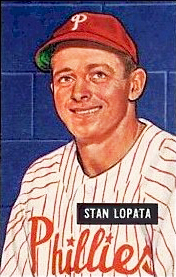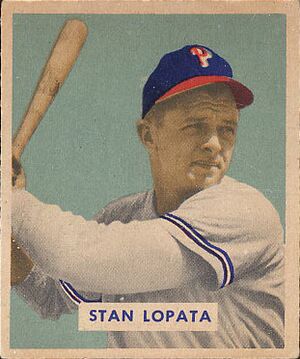Stan Lopata facts for kids
Quick facts for kids Stan Lopata |
|||
|---|---|---|---|
 |
|||
| Catcher | |||
| Born: September 12, 1925 Delray, Michigan, U.S. |
|||
| Died: June 15, 2013 (aged 87) Philadelphia, Pennsylvania, U.S. |
|||
|
|||
| debut | |||
| September 19, 1948, for the Philadelphia Phillies | |||
| Last appearance | |||
| June 12, 1960, for the Milwaukee Braves | |||
| MLB statistics | |||
| Batting average | .254 | ||
| Home runs | 116 | ||
| Runs batted in | 397 | ||
| Teams | |||
|
|||
| Career highlights and awards | |||
|
|||
Stanley Edward Lopata (September 12, 1925 – June 15, 2013) was an American professional baseball player. He played as a catcher in Major League Baseball (MLB) for 13 seasons. Stan played for the Philadelphia Phillies and the Milwaukee Braves.
In his career, Lopata played 853 games. He had a batting average of .254, which means he got a hit about a quarter of the times he tried. He also hit 116 home runs and helped his team score 379 runs. Stan was chosen for the All-Star team twice. He was also the first catcher in the National League to wear glasses during games!
Contents
Early Life and Baseball Dreams
Stan Lopata was born in Delray, a neighborhood in Detroit, Michigan. He went to Southwestern High School. After serving in World War II in Europe in 1945, Stan began his professional baseball journey.
He started in the minor leagues with the Terre Haute Phillies in 1946. The Phillies signed him with a $20,000 bonus, which was a lot of money back then! They found him playing really well in local baseball leagues in Detroit. In his first season, he hit .292, which was very good.
In 1947, Stan continued to shine. He moved up to the Utica Blue Sox team. He hit .325 with 9 home runs and was named the league's Most Valuable Player (MVP). He even hit a home run in the 13th inning of a championship game to help his team win!
By 1948, Stan was playing for the Toronto Maple Leafs, a Class AAA team. He kept hitting well, with a .279 batting average and 15 home runs. On May 20, he had an amazing day, hitting two home runs and bringing in eight runs in one game! Scouts started calling him a "can't miss" player, meaning they were sure he would be a big star.
Playing for the Philadelphia Phillies
Stan Lopata finally made it to the big leagues on September 13, 1948. He joined the Philadelphia Phillies. His first game was on September 19, where he played catcher. He got his first hit, a double, the very next day.
In 1949, Stan impressed his manager so much during spring training that he became the starting catcher. The Phillies were a young team that year, known as the "Fighting Phillies of '49." Stan had a good first full season, hitting .271 with 8 home runs.
The 1950 season saw Stan as a backup catcher. The Phillies, called the "Whiz Kids" because they were so young, won the National League championship. They played in the 1950 World Series but lost to the New York Yankees. Stan was in the game when the Yankees won, striking out for the final out.
Stan had some tough years after that, dealing with injuries. In 1951, he was sent back to the minor leagues. But he kept working hard and came back to the Phillies in 1952 and 1953, playing as a backup.
Stan's Unique Batting Style
The 1954 season was a turning point for Stan. He started using a very low, unique batting stance, almost like he was sitting in an easy chair! At first, people laughed, but then he started getting a lot of hits. He hit .396 in June, and pitchers tried to argue his stance was illegal, but it wasn't.
Around this time, Stan also started wearing tinted glasses because of the bright lights at the stadium. This made him the first catcher in the National League to wear glasses during games! He had his best season yet in 1954, hitting .290 with 14 home runs.
In 1955, Stan continued to play great. He was even chosen for the All-Star Game as a replacement for an injured player. He helped the National League win that game! He also started playing first base sometimes, especially against left-handed pitchers. He hit .272 with 22 home runs that year.
Stan had a scary moment in September 1955 when he collapsed twice during a game. Doctors thought it was from being hit by a ball earlier. Luckily, he recovered quickly and was back playing a few days later.
All-Star Seasons
Stan's best year was 1956. He became an everyday player and hit 32 home runs, which was a team record for right-handed batters at the time! He also had 95 runs batted in. He hit a walk-off home run to win a game in the 11th inning. Stan was chosen for his second All-Star team that year. He led all major league catchers in slugging percentage, showing how powerful his hits were.
In 1957, Stan's performance started to dip a bit due to injuries, especially to his shoulder and knee. Even with injuries, he still hit 18 home runs and had the best offensive numbers among National League catchers. He spent the off-season working to strengthen his knee.
The 1958 season was tough for Stan. His knee continued to bother him, and he got hit in the head by a pitch, which kept him out for a few days. He finished the season with 9 home runs.
Milwaukee Braves and Retirement
In 1959, Stan was traded to the Milwaukee Braves. He was excited about the move, hoping for a fresh start. However, he didn't play much and struggled to get hits. He was released by the Braves at the end of the season.
The Braves brought him back for the 1960 season, hoping he would do better. Stan played well in spring training, even hitting another walk-off home run. But in the regular season, he only played in 7 games before being sent to the minor leagues again. He played well for the Louisville Colonels, hitting 12 home runs.
Stan's final professional game was a high note. He helped the Louisville Colonels win the "Little World Series" against another minor league team. After that, at age 34, his professional baseball career came to an end.
Life After Baseball
After retiring from baseball, Stan Lopata worked at a steel plant. Later, he moved back to Philadelphia and worked for IBM. He then worked for a concrete company and became a vice president of sales before retiring.
Stan was honored for his career. In 1988, he was inducted into the Pennsylvania Sports Hall of Fame. Nine years later, in 1997, he was also inducted into the National Polish American Sports Hall of Fame.
Stan Lopata passed away on June 15, 2013, due to heart problems.
Images for kids




